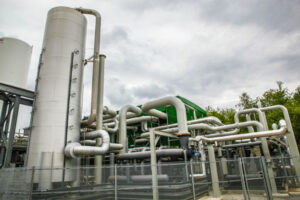Ørsted, Highview Power say liquid air energy storage tests show value


Highview Power’s first liquid air energy storage plant, he Pilsworth Liquid Air Energy Storage system. (Credit: Highview Power)
Highview Power and Ørsted have completed a joint investigation into how combining the technologies of liquid air energy storage (LAES) and offshore wind could provide greater value for investors and consumers.
The two companies carried out an analysis of technical performance, route to planning approval, and route to market with a regulatory and economic assessment. They say there is added value in combining offshore wind with LAES to support reducing wind curtailment, increasing productivity, and helping the move to a more flexible, resilient zero-carbon grid.
LAES is a variation on compressed air energy storage (CAES) using liquid air rather than compressed air – off-peak power is harnessed to produce liquid air. Highview Power is already developing up to 2 GWh of long-duration LAES across Spain. Up to seven of Highview’s “CRYOBatteries” use liquid air as the storage medium. Two small-scale versions are already operating in the UK.
GO DEEPER: Check out the Factor This! energy storage podcast playlist, including episodes on battery storage, long-duration energy storage, gravity storage, and more. Subscribe wherever you get your podcasts.
Unlike other large-scale energy storage solutions, LAES does not have geographical restrictions such as the need to be located in mountainous areas or where there are reservoirs, which could render it more viable for a range of operations. The technology turns air into liquid through refrigeration (cooling to -196°C) and storing it in insulated vessels. When power is required, liquid air is drawn from the tanks and pumped to high pressure. The technology can also use waste heat and cold from its own and other processes to enhance its efficiency.
As a result of this study, the companies believe a project can be developed and built along the timeline of an offshore wind farm. The partners will submit their findings to the UK Government’s “Long Duration Energy Storage” consultation process.
According to the companies, storage systems will play a crucial role in supporting the stability of the power network and improving the efficiency of the offshore wind farms, encouraging future investment in renewable energy that will boost the UK’s energy and cut consumer bills.
The UK will need up to 100 GWh of energy storage by 2050 according to the estimates from National Grid ESO’s Future Energy Systems Scenario.



